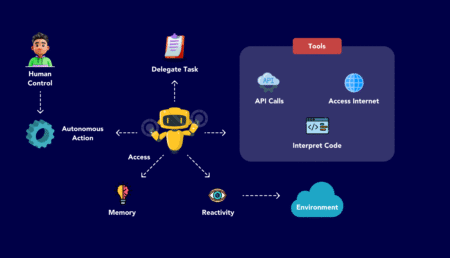The blog discusses how predictive analytics can transform performance engineering by enabling teams to detect and resolve software bottlenecks before they impact users. By leveraging historical data and real-time metrics, enterprises can forecast issues, optimize systems, and improve application reliability.
The post Predictive analytics in Performance Engineering: Identifying Bottlenecks Before They Happen first appeared on TestingXperts.
Libraries & Frameworks
Laravel’s containsOneItem() method now supports closures for custom condition validation, enabling verification that exactly one collection item meets specific criteria.…
A seamless integration between Prism and Model Context Protocol (MCP) servers that empowers your AI applications with powerful, external tool…
The blog discusses how Agentic AI can upscale DevSecOps by enabling autonomous security testing, continuous risk assessment, and intelligent decision-making within CI/CD pipelines. It proactively detects vulnerabilities, adapts testing workflows based on context, and supports instant incident response.
The post DevSecOps with Agentic AI: Autonomous Security Testing in CI/CD Pipelines first appeared on TestingXperts.
If you install Laravel 12, you are immediately prompted to choose the starter kit. What if you don’t know much…
Something incredible just happened: Filament now runs natively inside an Android app thanks to you. The post Filament Is Now…
This Laravel Blade + Apline.js starter kit emphasizes simplicity by offering a lightweight, Blade-only kit. The post A Blade-Only Starter…
I’m working with Java and REST Assured to test REST APIs. I was trying the example with JSON schema validation but it throws this error:
java.lang.IllegalArgumentException: Schema to use cannot be null
at io.restassured.module.jsv.JsonSchemaValidator.validateSchemaIsNotNull(JsonSchemaValidator.java:270)
at io.restassured.module.jsv.JsonSchemaValidator.access$300(JsonSchemaValidator.java:75)
at io.restassured.module.jsv.JsonSchemaValidator$JsonSchemaValidatorFactory.create(JsonSchemaValidator.java:281)
at io.restassured.module.jsv.JsonSchemaValidator.matchesJsonSchema(JsonSchemaValidator.java:166)
at io.restassured.module.jsv.JsonSchemaValidator.matchesJsonSchemaInClasspath(JsonSchemaValidator.java:117)
at suites.SchemaFollowupTest.ContractFollowUpTestSuccess(SchemaFollowupTest.java:44)
at java.base/jdk.internal.reflect.NativeMethodAccessorImpl.invoke0(Native Method)
at java.base/jdk.internal.reflect.NativeMethodAccessorImpl.invoke(NativeMethodAccessorImpl.java:62)
My test code is:
given()
.header(“Content-Type”, ContentType.JSON)
//.header(“Authorization”, “Bearer ” + ConfigEnvironments.TOKEN_K8S)
.body(jsonBody)
.when()
.post(ConfigEnvironments.BASE_URL_CLAIMENGINE +”/api/v1/FollowUp”)
.then().log().all()
.statusCode(202)
.and()
.body(matchesJsonSchemaInClasspath(“src/test/resource/followup-schema.json”));
My strucuture folder is here:
[1]: https://i.sstatic.net/K9m2UjGy.png
Laravel’s relationLoaded() method now supports dot notation for nested relationships, matching the syntax used for eager loading. This enhancement eliminates…
Eric and Brent discuss the evolution of PHP, the importance of testing, and the introduction of Tempest, a new PHP…
In a groundbreaking move that underscores a pivotal shift in financial policy, the Trump administration has unveiled a bold pro-cryptocurrency stance, setting the stage for the United States to emerge as a global leader in the digital financial revolution. This policy pivot not only reflects the administration’s recognition of cryptocurrency’s transformative potential but also signals a new era of economic innovation and empowerment.The Context: Why Now?Cryptocurrency has transitioned from a niche interest to a mainstream financial instrument, with Bitcoin and other digital currencies capturing the imagination of investors, businesses, and governments worldwide. The Trump administration’s endorsement comes at a time when cryptocurrencies are gaining traction as viable assets for hedging against inflation, facilitating cross-border transactions, and fostering financial inclusion.Vice President JD Vance’s recent address at the Bitcoin 2025 conference in Las Vegas was a watershed moment, as he articulated the administration’s commitment to supporting the crypto ecosystem. His declaration that cryptocurrency represents a “hedge against poor policymaking and inflation” encapsulates the administration’s strategic vision.Key Policy InitiativesTax Incentives for Crypto Adoption:
The administration plans to introduce tax breaks for businesses and individuals transacting in cryptocurrencies. This initiative aims to encourage wider adoption while bolstering the U.S. economy’s digital transformation.Regulatory Clarity:
In a move to attract blockchain startups and fintech firms, the administration has committed to creating a regulatory framework that balances innovation with investor protection. This approach is designed to eliminate ambiguities that have historically deterred investment in the crypto sector.Integration of Cryptocurrency in 401(k) Plans:
The Department of Labor’s revised guidance empowers fiduciaries to include cryptocurrencies in retirement portfolios, offering Americans diversified investment options for their future.Public-Private Partnerships:
To accelerate blockchain adoption, the administration is fostering collaborations between federal agencies and private-sector innovators. These partnerships aim to explore applications in supply chain management, cybersecurity, and beyond.Strategic ImplicationsThe Trump administration’s pro-crypto stance is not merely a policy decision; it’s a strategic move to position the United States as a trailblazer in the global crypto economy. By embracing digital currencies, the administration aims to:Enhance Financial Sovereignty:
Reducing reliance on traditional banking systems aligns with the broader goal of fostering a resilient and self-reliant economy.Attract Foreign Investment:
A crypto-friendly environment is expected to draw significant investment from global tech giants and blockchain startups.Strengthen Geopolitical Standing:
As nations like China and the European Union intensify their focus on central bank digital currencies (CBDCs), the U.S. seeks to maintain its competitive edge by championing decentralized finance (DeFi).Public Reception and CriticismWhile the policy shift has been lauded by crypto enthusiasts and industry leaders, it has also faced criticism from skeptics who highlight concerns about market volatility, fraud, and environmental impact. The administration’s challenge lies in addressing these issues without stifling innovation.Looking AheadThe Trump administration’s pro-crypto stance marks a significant milestone in the evolution of financial policy. By embracing the potential of cryptocurrencies and blockchain technology, the U.S. is poised to lead a global economic transformation. However, the success of this strategy will depend on the administration’s ability to navigate challenges and build a robust, inclusive framework that benefits all stakeholders.As the world watches, the United States stands at the forefront of a financial revolution. The question remains: Will this bold gamble pay off in securing economic prosperity and technological leadership for generations to come? Only time will tell, but the foundation has been laid for an exciting future.
GameStop, a name synonymous with the retail gaming industry, has made a bold move that is reshaping its corporate narrative and strategy. By investing $500 million in Bitcoin, the company has signaled its commitment to innovation and its readiness to embrace the burgeoning cryptocurrency market. This monumental decision not only diversifies GameStop’s portfolio but also aligns it with the growing institutional acceptance of digital assets.The Investment: A Closer LookIn a landmark announcement, GameStop disclosed its acquisition of 4,710 bitcoins, valued at approximately $513 million at current market rates. This move marks the company’s first significant foray into the cryptocurrency space and represents a strategic pivot towards leveraging blockchain technology and decentralized finance (DeFi) opportunities.Why Bitcoin?Bitcoin’s status as a digital gold and a hedge against economic uncertainty has made it a prime choice for institutional investors. For GameStop, the decision to invest in Bitcoin aligns with several strategic objectives:Portfolio Diversification:
By incorporating Bitcoin into its treasury, GameStop is hedging against fiat currency depreciation and traditional market volatility.Alignment with Market Trends:
As more corporations add Bitcoin to their balance sheets, GameStop’s move positions it among forward-thinking entities embracing digital transformation.Investor Confidence:
The investment sends a strong signal to stakeholders about the company’s innovative mindset and commitment to long-term growth.Strategic ImplicationsThis $500 million Bitcoin investment is more than a financial decision; it’s a strategic statement. Here’s how this move could shape GameStop’s future:Enhanced Market Perception:
By entering the crypto space, GameStop is positioning itself as a modern, tech-savvy organization capable of adapting to evolving market dynamics.Attraction of Crypto Enthusiasts:
The investment is likely to resonate with the growing community of cryptocurrency advocates and retail investors, potentially boosting GameStop’s stock performance and brand loyalty.Foundation for Blockchain Integration:
GameStop’s investment could pave the way for blockchain-based initiatives, such as integrating cryptocurrencies into its payment systems or developing NFT-based gaming assets.Industry ReactionsGameStop’s bold step has garnered mixed reactions from industry analysts and market observers:Supportive Voices:
Crypto advocates and tech enthusiasts have praised the move as a forward-looking strategy that aligns with global financial trends.Skepticism:
Critics caution against potential risks, citing Bitcoin’s volatility and the environmental concerns associated with cryptocurrency mining.The Bigger PictureGameStop’s Bitcoin investment is part of a broader trend of corporate adoption of cryptocurrencies. From Tesla’s Bitcoin purchases to MicroStrategy’s significant holdings, companies are increasingly recognizing the potential of digital assets to drive growth and innovation.For GameStop, this move could serve as a catalyst for further transformation. With its roots in retail gaming, the company has faced challenges in adapting to the digital era. By embracing Bitcoin, GameStop is signaling its intent to evolve and thrive in a rapidly changing economic landscape.What’s Next for GameStop?GameStop’s $500 million Bitcoin investment is more than a headline—it’s a harbinger of the company’s future direction. As it explores the possibilities of blockchain and cryptocurrency, GameStop has the opportunity to:Innovate in Gaming:
Integrate blockchain technology to create decentralized gaming ecosystems or introduce tokenized rewards for players.Expand Revenue Streams:
Leverage Bitcoin and other cryptocurrencies to diversify its income sources.Lead Industry Trends:
Set an example for other traditional businesses looking to venture into the crypto space.ConclusionGameStop’s $500 million Bitcoin investment is a bold step that underscores the company’s commitment to innovation and its vision for the future. While the move comes with risks, it also holds immense potential to redefine GameStop’s brand and market position. As the company navigates this new chapter, all eyes will be on how it leverages this investment to drive growth and create value for its stakeholders.In an era of digital transformation, GameStop’s leap into cryptocurrency represents a strategic alignment with the future of finance. Whether this gamble pays off will depend on the company’s ability to adapt and innovate, but one thing is clear: GameStop is ready to play a leading role in the crypto revolution.
India’s tryst with cryptocurrency is a narrative of transformation, marked by initial skepticism, growing acceptance, and the potential to lead in the global digital finance landscape. With over 100 million crypto owners and a rapidly expanding digital ecosystem, India is uniquely positioned to become a powerhouse in cryptocurrency adoption and innovation.A Complex Relationship: The Early DaysIndia’s relationship with cryptocurrency began on a cautious note. Regulatory uncertainty, coupled with concerns about illicit activities and financial instability, led to significant resistance from policymakers. The Reserve Bank of India (RBI) even issued a ban on crypto transactions in 2018, a move that stifled growth and innovation.However, the Supreme Court’s decision in 2020 to lift the ban marked a turning point. This judicial intervention not only revived the crypto ecosystem but also instilled confidence among investors, entrepreneurs, and the tech-savvy younger generation.The Current Landscape: A Digital AwakeningIndia’s crypto market has since witnessed exponential growth. With over 820 million active internet users, a robust talent pool, and an increasing appetite for digital assets, the country has emerged as a significant player in the global crypto economy. Key factors driving this surge include:Tech-Savvy Population:
India’s youth, armed with smartphones and high-speed internet, is at the forefront of the crypto revolution. Platforms like WazirX, CoinDCX, and ZebPay have democratized access to digital currencies.Cross-Border Transactions:
Cryptocurrencies have provided a cost-effective and efficient alternative for remittances, benefiting India’s large diaspora community.Entrepreneurial Ecosystem:
The rise of blockchain startups and crypto exchanges has fostered innovation and job creation in the fintech sector.Challenges on the PathWhile the growth story is impressive, India’s crypto journey is not without hurdles. The absence of a clear regulatory framework continues to pose challenges, including:Investor Protection:
Lack of safeguards against scams and frauds has deterred some from entering the market.Taxation Ambiguities:
Uncertainty around the taxation of crypto transactions creates complexities for investors and businesses.Environmental Concerns:
Bitcoin mining’s energy-intensive process has sparked debates about sustainability, particularly in a country grappling with energy needs.Government’s Evolving StanceThe Indian government’s approach to cryptocurrency has evolved from outright bans to cautious exploration. Recent developments include:Consultative Committees:
The formation of expert panels to study the implications of cryptocurrencies and blockchain technology.Digital Rupee Initiative:
The RBI’s pilot projects for a Central Bank Digital Currency (CBDC) reflect a measured embrace of digital finance.Public Awareness Campaigns:
Efforts to educate citizens about the risks and opportunities associated with cryptocurrencies.The Road Ahead: Opportunities for LeadershipIndia’s crypto adoption journey is at a crossroads. With strategic interventions, the country can leverage its strengths to become a global leader in the digital economy. Key steps include:Regulatory Clarity:
Establishing transparent and balanced regulations to foster growth while protecting investors.Blockchain Integration:
Promoting the use of blockchain in governance, supply chain management, and healthcare to demonstrate its transformative potential.Global Collaboration:
Engaging with international bodies to set global standards and attract foreign investments.ConclusionIndia’s journey from skepticism to emerging leadership in cryptocurrency is a testament to its resilience and adaptability. As the world’s largest democracy navigates this digital revolution, its choices will shape not only its economic future but also the global crypto narrative.By embracing innovation, addressing challenges, and fostering a collaborative ecosystem, India has the potential to redefine its financial landscape and inspire other nations to follow suit. The crypto era is here, and India’s role in shaping its trajectory is both critical and promising.
In a move that underscores the growing convergence of media, technology, and finance, Trump Media & Technology Group (TMTG) has announced an ambitious $3 billion crypto investment plan. This groundbreaking initiative seeks to position the company as a trailblazer in the digital economy, leveraging blockchain technology and cryptocurrencies to redefine content creation, distribution, and monetization.The Vision Behind the InvestmentTMTG’s foray into cryptocurrency represents a strategic pivot aimed at capitalizing on the explosive growth of the digital finance ecosystem. By integrating blockchain technology into its operations, the company plans to:Revolutionize Content Monetization:
Introduce blockchain-based platforms that allow content creators to earn directly from their audiences without intermediaries.Enhance User Engagement:
Utilize tokenized rewards to incentivize user interactions, fostering loyalty and community growth.Pioneer Decentralized Media:
Develop decentralized platforms that empower users with greater control over their data and content.Key InitiativesThe $3 billion crypto investment plan includes several transformative projects:Launch of TrumpCoin:
TMTG is reportedly developing a proprietary cryptocurrency, TrumpCoin, designed to serve as the backbone of its digital ecosystem. Users will be able to use TrumpCoin for subscriptions, premium content, and platform-specific rewards.Blockchain-Powered Media Hub:
A blockchain-based media platform is in the works, enabling secure, transparent, and tamper-proof content distribution.NFT Marketplace:
TMTG plans to launch a marketplace for non-fungible tokens (NFTs), allowing creators to tokenize and sell unique digital assets, from exclusive videos to limited-edition merchandise.Investment in Blockchain Startups:
The company intends to allocate a significant portion of the $3 billion fund to invest in blockchain startups, fostering innovation and partnerships in the crypto space.Strategic ImplicationsTMTG’s crypto investment plan is not just a financial maneuver; it’s a strategic vision aimed at:Diversifying Revenue Streams:
By integrating cryptocurrency and blockchain, TMTG can explore new revenue models that are less reliant on traditional advertising.Establishing Market Leadership:
With this bold move, TMTG positions itself as a pioneer in the intersection of media and blockchain technology.Driving Global Expansion:
Cryptocurrencies offer a borderless financial system, enabling TMTG to expand its reach to international audiences with minimal friction.Industry ReactionsTMTG’s announcement has elicited varied reactions from industry experts:Optimism:
Crypto enthusiasts and blockchain advocates have lauded the plan as a forward-thinking initiative that could set a new standard for the media industry.Skepticism:
Critics have raised concerns about the volatility of cryptocurrencies and the regulatory challenges associated with blockchain adoption.Challenges and RisksWhile the $3 billion investment plan is ambitious, it comes with its share of challenges:Regulatory Uncertainty:
Cryptocurrencies and blockchain technologies operate in a rapidly evolving regulatory landscape, posing potential hurdles.Market Volatility:
The inherent volatility of cryptocurrencies could impact the stability of TMTG’s financial model.Technical Execution:
Successfully implementing blockchain-based solutions requires significant technical expertise and infrastructure investment.Looking AheadTMTG’s $3 billion crypto investment plan represents a bold step towards redefining the future of media and technology. By embracing blockchain and cryptocurrencies, the company aims to create a more inclusive, transparent, and user-centric media ecosystem.As TMTG embarks on this transformative journey, its success will hinge on its ability to navigate regulatory landscapes, manage technological complexities, and deliver tangible value to its users and stakeholders. If executed effectively, this initiative could not only cement TMTG’s position as a leader in the media industry but also inspire other companies to explore the untapped potential of blockchain technology.The world is watching, and TMTG’s crypto investment plan could very well be the blueprint for the next era of digital innovation.
As the cryptocurrency market continues to mature, 2025 is poised to be a pivotal year, marked by innovation, adoption, and regulatory advancements. From decentralized finance (DeFi) to environmental sustainability, the crypto space is evolving in ways that could redefine the global financial ecosystem. Here are the top cryptocurrency trends to watch in 2025.1. Mainstream Institutional AdoptionThe integration of cryptocurrencies into mainstream financial systems is accelerating. By 2025, institutional adoption is expected to reach unprecedented levels, driven by:Central Bank Digital Currencies (CBDCs):
Countries worldwide are developing CBDCs, signaling broader acceptance of blockchain technology in traditional finance.Crypto ETFs and Mutual Funds:
Regulatory approvals are paving the way for crypto-focused exchange-traded funds (ETFs), making digital assets more accessible to institutional and retail investors.Corporate Integration:
Companies are increasingly holding cryptocurrencies as treasury assets and accepting them as payment, normalizing their use in commerce.2. Expansion of Decentralized Finance (DeFi)DeFi platforms continue to disrupt traditional financial services, offering decentralized lending, borrowing, and trading options. Emerging trends in DeFi for 2025 include:Cross-Chain Interoperability:
Enhanced protocols will enable seamless transactions between different blockchain networks, reducing fragmentation in the DeFi space.DeFi 2.0 Innovations:
New financial products and models, such as tokenized insurance and decentralized credit scoring, will drive growth.Mainstream Accessibility:
Simplified user interfaces and lower entry barriers will attract non-technical users to DeFi platforms.3. Rise of Layer-2 SolutionsScalability and transaction speed remain critical challenges for major blockchains like Ethereum. Layer-2 solutions, which operate on top of existing blockchains, are set to address these issues. Key developments include:Optimistic and ZK-Rollups:
These technologies will significantly enhance throughput and reduce transaction costs.Integration with Web3:
Layer-2 solutions will play a crucial role in enabling seamless decentralized applications (dApps).4. NFT Evolution and UtilityNon-fungible tokens (NFTs) have moved beyond art and collectibles, finding utility in:Gaming:
Play-to-earn (P2E) models and metaverse integrations are driving demand for gaming-related NFTs.Digital Identity:
NFTs are emerging as tools for digital identity verification, with potential applications in healthcare, education, and beyond.Tokenization of Real Assets:
Real estate, luxury goods, and intellectual property are increasingly being tokenized, unlocking liquidity and democratizing ownership.5. Enhanced Regulatory ClarityThe regulatory landscape for cryptocurrencies is becoming clearer, as governments recognize their transformative potential. Expected regulatory trends for 2025 include:Global Standards:
Collaboration between nations to create unified regulations for cryptocurrencies and blockchain technologies.Focus on Consumer Protection:
Policies aimed at safeguarding investors while promoting innovation.Taxation Reforms:
Simplified frameworks for crypto taxation to encourage compliance and transparency.6. Emphasis on SustainabilityEnvironmental concerns around cryptocurrency mining have led to a focus on sustainable practices. Innovations in 2025 include:Green Mining:
Transition to renewable energy sources and more energy-efficient consensus mechanisms like Proof-of-Stake (PoS).Carbon Credits Integration:
Cryptocurrencies linked to carbon credits could incentivize eco-friendly behaviors.Blockchain for Sustainability:
Leveraging blockchain for tracking and verifying sustainability initiatives.7. Enhanced Security and Privacy FeaturesAs the crypto ecosystem grows, so does the need for robust security and privacy. Innovations to watch include:Quantum-Resistant Cryptography:
Developing protocols to withstand potential threats from quantum computing.Privacy Coins Evolution:
Enhanced privacy-focused cryptocurrencies offering better compliance with regulatory standards.Secure Wallets and Custodial Services:
Advances in wallet technologies to prevent hacks and ensure user safety.8. Integration with Traditional FinanceThe lines between traditional and digital finance are blurring. By 2025, expect:Hybrid Financial Products:
Solutions combining crypto and fiat features to offer the best of both worlds.Bank Partnerships:
Collaboration between crypto platforms and traditional banks to offer seamless services.Crypto-Powered Credit Systems:
Lending and credit scoring systems that incorporate blockchain transparency and efficiency.9. Metaverse and Web3 ExpansionCryptocurrencies are central to the development of the metaverse and Web3. Key trends include:Virtual Economies:
Cryptos and tokens underpin virtual goods and services in the metaverse.Decentralized Internet:
Blockchain-based Web3 initiatives promoting user sovereignty over data.Interoperable Digital Assets:
Assets that work across multiple platforms and virtual worlds.10. Focus on Education and AwarenessAs crypto adoption grows, so does the need for public understanding. Educational initiatives in 2025 will emphasize:Financial Literacy Programs:
Governments and private entities will invest in teaching crypto fundamentals.Developer Training:
Upskilling tech talent to support blockchain innovations.Consumer Awareness Campaigns:
Promoting safe practices and scam prevention.ConclusionThe cryptocurrency landscape in 2025 is shaping up to be dynamic and transformative. From institutional adoption to sustainability and technological advancements, these trends will play a pivotal role in defining the future of digital finance. As investors, businesses, and governments align with these developments, the potential for growth and innovation in the crypto sector is limitless.
AI agents are everywhere from Siri answering your voice commands to self-driving cars making split-second decisions on the road. These autonomous programs are transforming the way businesses operate by handling tasks, improving efficiency, and enhancing decision-making across industries. But what exactly is an AI agent? In simple terms, an AI agent is an intelligent system
The post AI Agent Examples: Transforming Technology appeared first on Codoid.
Laravel’s Str::isUrl method provides flexible URL validation with optional protocol restrictions. This utility simplifies verifying URL format and security requirements,…
Laravel’s diffKeys method identifies collection differences based on keys rather than values, enabling precise structural comparisons. This utility excels in…
The Laravel team released v12.16.0, with a fluent Rule::contains() validation rule, an “in_array_keys” validation rule, a new Arr::hasAll() method, and…
Useful Laravel links to read/watch for this week of May 29, 2025. Source: Read MoreÂ










